China has a long history of loving and appreciating flowers, but in fact, before the Northern and Southern Dynasties, flowers were rarely used as the main decorative motifs in life, from the Shang and Zhou dynasties to the Han dynasty, the dominant decorative motifs were mainly animal and geometric.
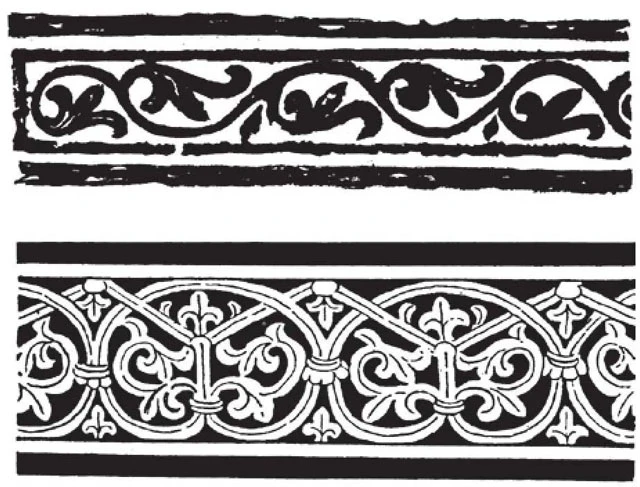
It was not until the Wei-Jin-North and South Dynasties periods that, with the introduction of Buddhism, the Lonicera twining pattern was introduced into China, and under the development and effect of cultural intermingling, the Lonicera twining pattern with exotic colors was combined with the local lotus pattern with auspicious symbolic meaning, forming a new form of decorative pattern.
These motifs first appeared in a large number in the decoration of religious instruments, and as they spread, they also appeared frequently in the decoration of secular crafts. In the Tang Dynasty, in addition to the floral patterns inherited from the Wei and Jin Dynasties, different floral shapes such as peonies and chrysanthemums, as well as the Baoxiang patterns also appeared in the expression of the decorative patterns.
The floral patterns of the Tang Dynasty are very different from the slender and delicate shapes of the Wei and Jin Dynasties, with rich and flamboyant compositions, full floral shapes, soaring lines and vigorous postures. Such patterns present a rich sense of layers from the inside out, dignified and rich in change, with rounded and smooth lines that flutter and roll, full of vigorous vitality and gorgeous colors.
Such gorgeous and unrestrained Tang floral motifs can be found on textiles, gold or silver objects, murals, and all kinds of utensils of the Tang Dynasty. Just as the Tang Dynasty society was unified, rising, confident and open, the floral decorative motifs of the Tang Dynasty also showed the same characteristics.
Stylistic Features and Characteristics of Tang Dynasty Floral Patterns
The Tang Dynasty was an era of openness and self-confidence. In the Tang Dynasty, the rich and luxurious aesthetic style covered almost all aspects of the plastic art field, which was manifested in the floral decorative motifs, and the background of the flourishing and open era of the Tang Dynasty was inextricably linked, forming a majestic style of decorative motifs. It is rich and exuberant in shape, unconstrained by cumbersome forms, free and rosy, evolving a new era based on the absorption of the previous dynasties and foreign cultures.
One of the main characteristics is the fullness of the shape and the dense structure, and the structure of the Tuan Hua (团花) is the representative of this structural feature. In the early Tang Dynasty, there were more scattered flowers and small Tuan Hua, while in the heyday of the Tang Dynasty, the layout structure of the Tuan Hua became more open, and the form also changed from the original generalized shape with geometric forms to a realistic form, and the overall shape of the motifs was full of structure, magnificent and graceful.
The rounded shape of Tang floral motifs is complemented by a full and dense composition, and even when the motifs are not Tuan Hua, this layered and full composition is sometimes reflected. The flowers, fruits, branches and leaves are clustered to form a full image, expressing the visual sensation of fullness and fruitfulness.
Another characteristic of Tang dynasty floral motifs is the use of curving lines to express the rhythm and hierarchy of the motifs, of which the twining pattern is a typical representative. Many Tang dynasty twining patterns are different from the traditional two-sided continuous or four-sided continuous patterns in terms of composition, and the pattern composition is a form of free and random scrolling. These free variations show the vigorous, ebullient and colorful appearance of the Tang dynasty twining pattern.
Such twining patterns take the stems, leaves, flowers, or fruits of different flowers and plants as their subject matter. From the early Tang dynasty to the heyday of the Tang dynasty, broad leaves or rolled leaves replaced the original simple form of twining, and eventually evolved into the Tang dynasty's unique scrolling grass pattern, whose shape is magnificent, with the images of flowers and leaves echoing each other and blending together. New botanical patterns were added more and more often, and developed into a wide variety of different forms of twining patterns. The Tang grape damask now collected at Japan's Nara Shosoin Temple, as well as the pattern of early Tang Guanyin skirt in Cave 334 of the Mogao Caves at Dunhuang, are representatives of this type of pattern.
In contrast to the dignified image of the Tuan Hua pattern, the extended twining pattern highlights the characteristics of Chinese plastic art, which is characterized by lines. Those patterns are rounded and smooth, the gyrations and overlaps of lines produce a dynamic rhythm of change, with the lines flying and rolling, which is the embodiment of the bold and exuberant spirit of the Tang people.
The floral motifs of the Tang Dynasty underwent an evolution from an abstract and decorative style at the beginning to a realistic style in the middle and late Tang dynasties, fully demonstrating its varied decorative styles. During this process, the economic development, the progress of handicraft technology, the refinement of people's demand for decorative beauty, and the development of foreign cultural exchanges all provided important material and spiritual support for the formation of the stylistic characteristics of floral patterns in the Tang Dynasty.
The style of decoration for the sake of decoration is one of the main stylistic features of floral motifs in the Tang Dynasty, and this style reached its peak during the heyday of the Tang dynasty. The non-realistic abstract decorative motifs such as the Bao Xiang Hua and the scrolling grass motifs, which are produced only for the pursuit of decorative effects, are precisely the product of this aesthetic interest.
In addition, the mixed combination of decorative motifs of different subjects also highlights the stylistic characteristics of this decoration. There are combinations of different plants in these patterns, such as the border decoration of Mogao Cave 329, an entwined branch on the main line with grapes and lotus flowers, an unnatural symbiosis that is the aesthetic product of the main purpose of the decoration.
There are also some that combine bird and animal patterns with floral patterns, such as the phoenix and butterfly floral pattern excavated from the Famen Temple in Shaanxi, in which the tail part of the phoenix pattern changes into the shape of a blooming flower. In some fabrics, the cloud-like tail feathers of the phoenix pattern are decorated with plant flowers and fruits. These fantastical combinations fully reflect the unconventional, flexible, and decoration-based non-realistic style of the Tang Dynasty.
In the middle and late Tang dynasties, another fresh and naturalistic realistic style became the main stylistic characteristic of Tang floral patterns in this period. As the economic and social stability of the Tang Dynasty was undermined to varying degrees, the aesthetic style of the Middle and Late Tang Dynasty was relatively transformed into a rigorous style, and the aesthetic mentality of seeking stability and dignity from reality in all fields of art prevailed.
In the field of painting, the emergence of flower and bird painting led to the emergence of realistic style botanical patterns, and the floral patterns of the Tang Dynasty in the Middle Tang Dynasty embarked on a path of capturing realistic emotional colors and pursuing more delicate visual feelings.
During this period, the flowering branch patterns occupied the decorative stage, small clusters of flowers pattern as a representative of the decorative form of flowering branch patterns, began to appear in large numbers in the form of textile printing, often arranged in scattered dots on the dress, scarf as decoration.
Such patterns can be seen on the dresses worn by the "Donor Portrait of Lady Wang from Taiyuan in Worship" in Cave 130 of the Mogao Caves. This pursuit breaks the non-realistic style of heavy decoration and allegorical, realistic style of drawing natural features of flowers and plants to become the mainstream of decorative patterns.
Typical floral and botanical patterns in Tang Dynasty Costume fabrics
Based on the inheritance of previous generations, the floral and botanical patterns of the Tang Dynasty evolved into a rich variety of pattern forms and composition methods.
As the main decorative patterns, floral and botanical patterns appeared in many fields of social life, especially in fabric pattern changes and women's clothing decoration, and floral and botanical patterns almost became the main choice of subject matter.
Peony motif
Peony is one of the motifs with the longest history and the widest range of application in Chinese arts and crafts decoration. The Tang Dynasty's love for peonies was the most popular among all dynasties. Apart from the beauty of peonies' unique flower color, there were also specific social reasons for this love.
Peony motifs were widely used in the costume, arts and crafts of the Tang Dynasty, such as brocade, gold or silver ware, bronze mirror, stone engraving, and painted murals. Peony motifs are often found on the shoulders of garments in the form of Tuan Ke (团窠, round or oval), or on the bodice part of garments in the form of folded branch patterns, or in the trim of garments in combination with wrapped branch patterns. These peony patterns are mostly expressed by embroidery and dyeing, with rich colors and exquisite craftsmanship.
Bao Xiang Hua motif
The pattern of the Bao Xiang Hua in Tang dynasty decorative patterns is a completely variation of the pattern, which is derived from the combination of the lonicera and lotus patterns, and is a new pattern formed through artistic processing.
It absorbs the image characteristics of various flowers, and through the stylized processing, it is extremely decorative. The petals of Tang Dynasty Bao Xiang Hua motif resemble Ruyi, and the flowers are mostly round to fit the pattern, with neat shape, strict structure, and rich and beautiful. It is the most prominent in the decoration application in the Tang Dynasty.
Bao Xiang Hua is not a realistic representation of real flowers, but its flower shape absorbs the characteristics of many types of flowers with auspicious meanings, such as the lotus flower from Buddhism, the peony representing wealth and prosperity, and the pomegranate flower with blessings, etc.
There is no fixed shape of the flower, but it is composed of a central "十" structure or a central radial structure, and the shape of its petals is very variable. In the Mogao Caves at Dunhuang, there are a large number of garments decorated with Bao Xiang Hua, and with the changing age of the caves, we may be able to glimpse the history of the evolution of the Bao Xiang Hua.
The image of the Bao Xiang Hua motifs in the early Tang Dynasty basically showed a square shape, and the image was also relatively brief showing four petals, with simple forms and prominent programmatic features.
During the heyday of the Tang Dynasty, the outline of Bao Xiang Hua became rounded, and the petal decorative forms were also more abundant, basically having the characteristics of the round shape of later generations.
In the Kaiyuan period, the flower shape of Bao Xiang Hua took on realistic features and absorbed the characteristics of the peony pattern at that time, gradually getting rid of the original stereotyped and simple appearance, with a fuller flower shape, more complex petal layers, and realistic petals and hearts, no longer stuck to the original central symmetrical shape.
The pattern of Bao Xiang Hua appears frequently in brocade, ware, and bronze mirror in the Tang Dynasty. In the brocade, the overlapping and complex petals of Bao Xiang Hua are rich and beautiful, which is the concentrated embodiment of the Tang Dynasty style.
Among the unearthed Tang Dynasty brocade relics, the Bao Xiang Hua pattern is in various forms, including the group flower pattern composed with birds and animals, and the twining pattern composed with curly grasses, with its brilliant color and luster, and the graceful and gorgeous juxtaposition of multiple colors with the characteristics of brocade.
Curly grass motif
The curly grass motif is a kind of flower and grass pattern that extends to the left and right or to the top and bottom in a wave-like pattern, which was popular in the Tang Dynasty. The pattern of curl grass originated from the pattern of Lonicera in the Wei and Jin dynasties, which was further developed in the Tang dynasty and eventually became a characteristic pattern that is well-known in China and abroad.
The Tang Dynasty curly grass pattern is mostly found in stone and brick carvings, and the branches are curled and wave-like, composed of more curved lines, lively and smooth, with beautiful forms. The curly grass pattern used in Tang Dynasty costumes was often combined with other floral patterns to become the twining branch pattern, which was commonly used as a border decoration in Ban Bi.
As early as the North and South Dynasties, curly plant patterns have appeared in traditional patterns, and are richer from structure to rhythm than the lonicera patterns that appeared earlier, with the leaves as the center of the two sides of the sub-petal.
After that, from Sui to Tang, the scroll grass pattern became more and more mature, and became one of the main plant patterns. The early forms of the Tang dynasty scrolling grass pattern still retain traces of the lonicera pattern, the branches are slender, and the flower heads embellished during the pattern are similar to those of the Bao Xiang Hua pattern.
With the prosperity of Tang culture and changes in aesthetic taste, the scroll grass pattern became fuller and fuller, the leaves became broader, the petals were more complex and fuller, and the flower head was mostly in the shape of pomegranate flowers.
In the late Tang period, the curly grass pattern returned to a concise and generalized form. Compared to other Tang dynasty patterns of the same period, the curly grass pattern is more abstract than its prototype, the curly grass pattern is basically detached from the original plant life form, seemingly only from the point of view of aesthetic needs, the form of the branches and vines flip back and forth, decorated with flowers between the leaves will also change with the change of fashion trends.
From a certain point of view, the curly grass pattern is similar to the Bao Xiang Hua pattern, which is why these two patterns legendarily occupy the pinnacle of floral patterns in the Tang Dynasty. Not only that, but the two patterns are combined to produce the twining branch Bao Xiang Hua pattern, which combines the strengths of each pattern.
In this pattern, the petals of the Bao Xiang Hua replace the leaves of the scrolling grasses in an entwined arrangement, with flowers as the main part of the pattern and branches as a supplement, which is ideal for the close decoration of textiles by embroidery.
Grape pattern
China has an early record of grapes.
《诗经·国风·周南·樛木》:“南有樛木,葛藟累之;乐只君子,福履绥之。”
《诗经·王风·葛藟》:“绵绵葛藟,在河之浒。”
The "葛藟" here refers to grapes, but it is a wild grape, which should be a completely different species from what is usually called grapes in later times. The grapes that survive in the ancient poems and decorative patterns are about the Western grapes that were introduced from the Han Dynasty, and subsequently brought a great contribution in terms of food, culture, and decoration.
In textiles, grape pattern is a common decoration, and this is also the main carrier on which the grape pattern is transmitted to the east.
Early grape patterns can be seen on Han Dynasty woolen fabrics excavated in Xinjiang. The use of grape patterns became more popular during the Wei-Jin and North-South dynasties. Grape patterns were not only found on textiles, but also on gold and silver objects, stone carvings, lacquer coffins, and other historical relics of the same period, where grape patterns were common and abundant.
During the Sui and Tang dynasties, grapes were more widely used as decorative motifs. In the early years of the Tang dynasty, due to the change of boundaries, made grape decorative patterns more popular.
In addition to the grape pattern alone, the combination of grapes with beasts and luan birds was widely used in the decoration of bronze mirrors and vessels. Grape patterns were also abundant on clothing fabrics, both in the form of twining grape patterns and flowering tree grape patterns.
The twining grape pattern is the most common form in the fabrics, generally in the form of a two-sided continuous band, but also in the form of a ring with the Tuan Ke pattern to form a new pattern, and also in the form of a four-sided continuous pattern to form an interesting whole pattern.
Compared with the previous dynasty, the grape pattern of the Tang Dynasty is fuller in shape, combining the imposing vine branches and leaves of the curly grass pattern with the full, realistic fruit, bringing out the recklessly gorgeous aesthetic of the Tang Dynasty.
Reference: Costume Research and Revitalization Design of Tang Dynasty
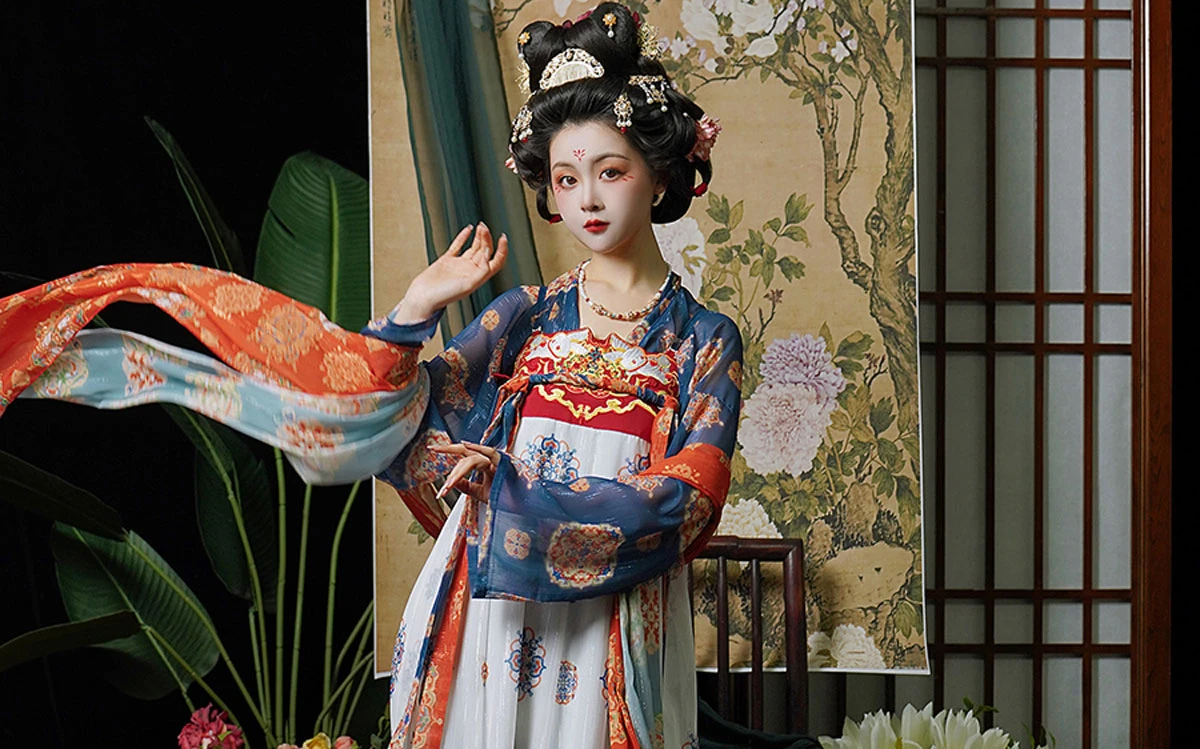


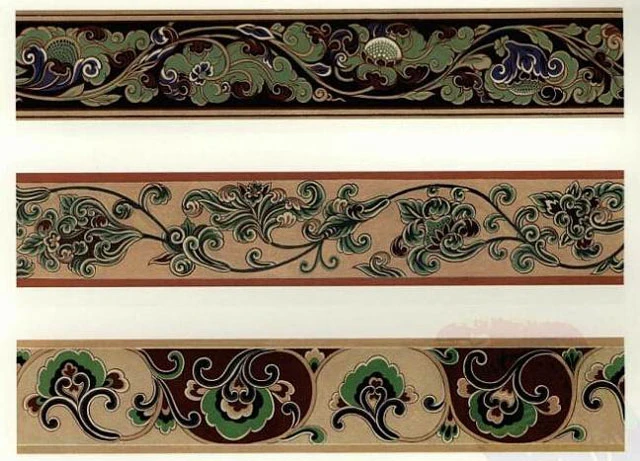



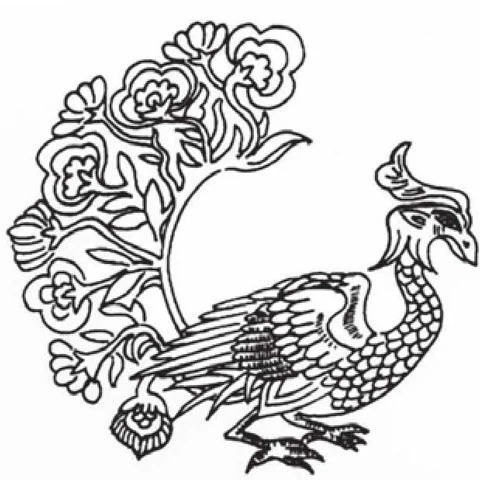
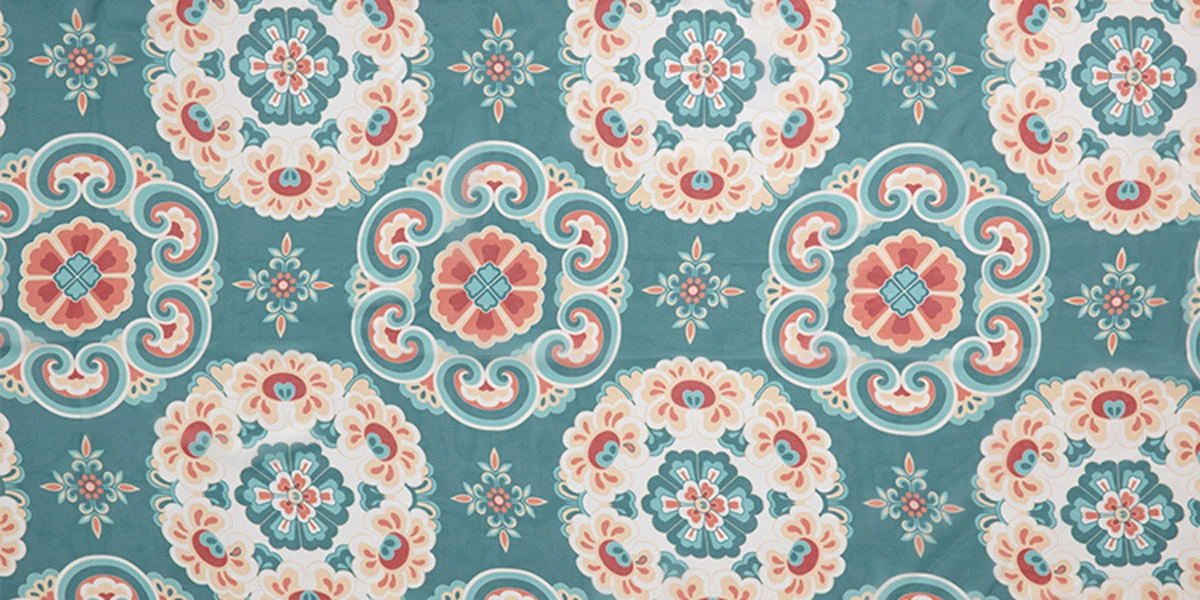



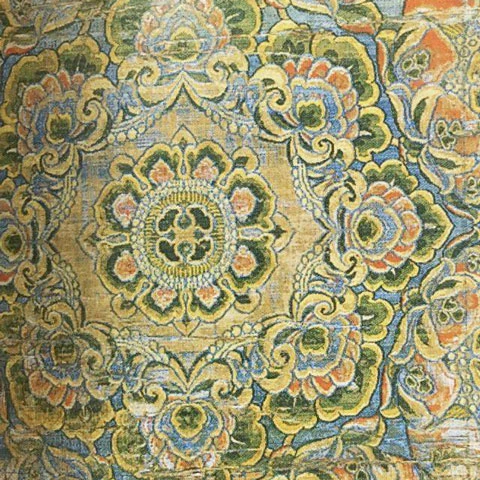

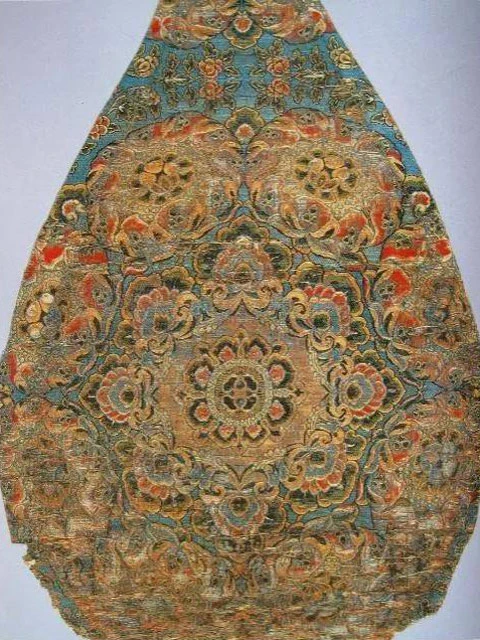



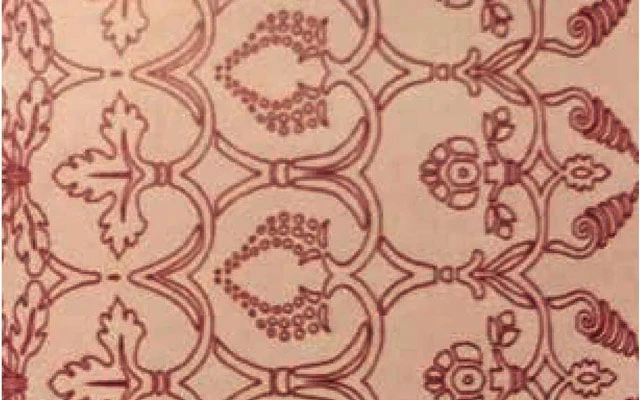
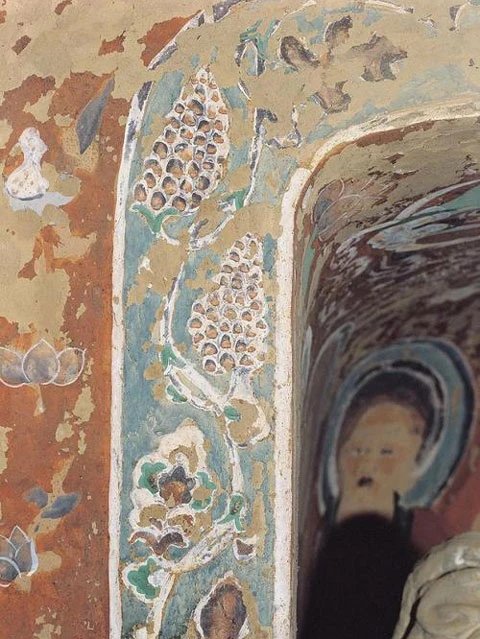
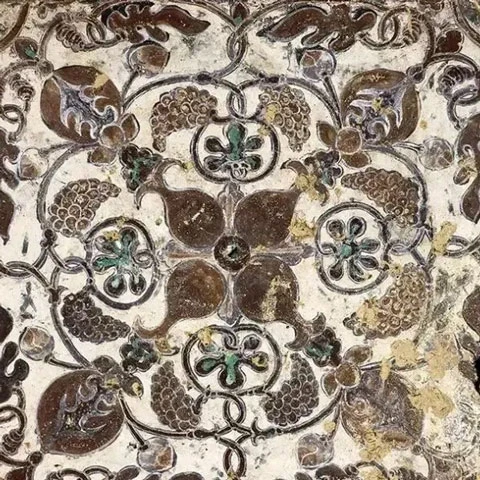

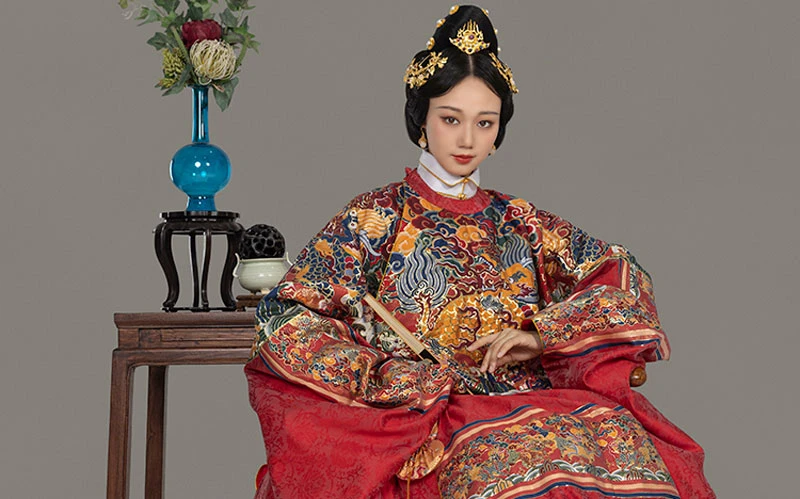

I'm so glad that the store now has a gorgeous blue, red, and white tang dynasty outfit like the ones in these pictures. I'm planning to buy soon, whether or not I am confident about actually wearing it out is another issue. But, it's just so gorgeous I can't resist
Very good😍
Thank you for articel